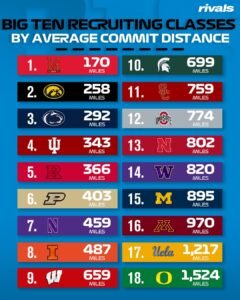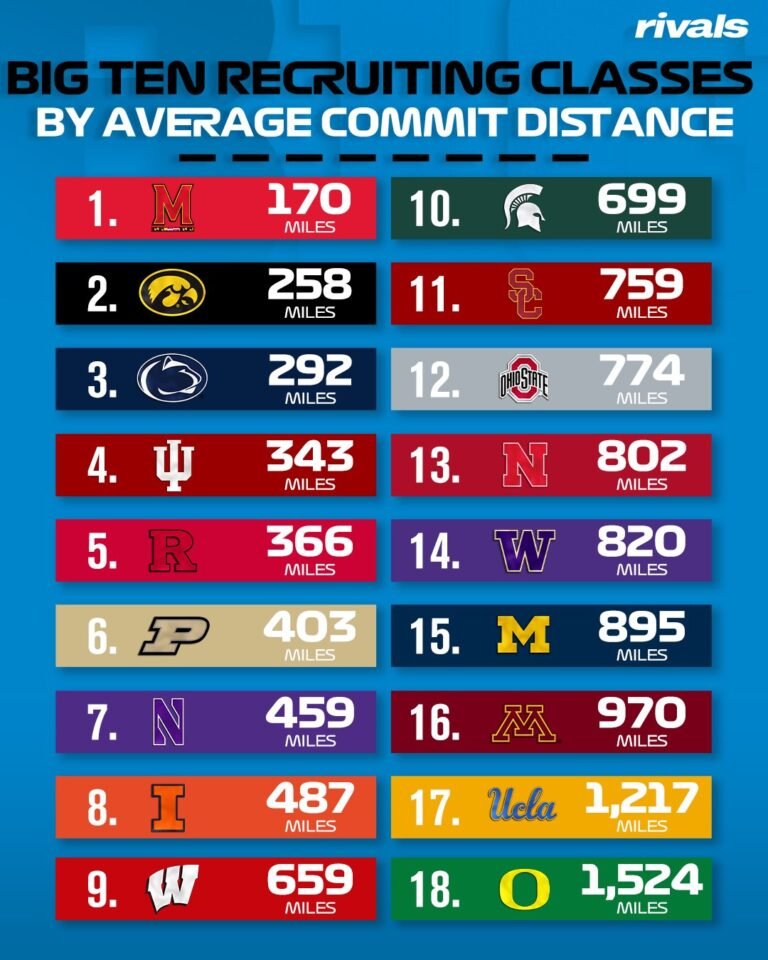What does “average commit distance” mean — and why it matters
“Average commit distance” refers to the mean travel (or “as‐the‐crow‐flies” or driving) distance between a prospect’s hometown or high school, and the college campus they commit to. If a Big Ten school has a recruiting class where many players are from nearby high schools, the average distance will be lower; if many recruits are from very far away (other states, far regions), the average will be higher.

This metric is interesting because it can shed light on recruiting strategy: do schools rely heavily on local talent pipelines, or do they cast a wider national (or even international) net? It also connects to fan & media perceptions of “homegrown” players, travel costs for families, which recruits are culturally or logistically more likely to commit, and the perceived prestige / draw of a program beyond its home region.
Methodological challenges & caveats
Before ranking, it’s worth mentioning what makes doing this accurately difficult:
- Data availability: Not all recruits’ hometowns are fully documented in consistent formats; for many classes, especially for smaller or less high‑profile programs, detailed hometown info and precise geolocation is non-trivial to assemble.
- Distance metric choice: Straight-line (“great circle”) distance is easier to compute but less reflective of real travel burden; driving distance/time might be more meaningful but harder to standardize.
- Variability & skew: A single out‑of‑state recruit from far away (e.g. West Coast, Tennessee, or Florida) can skew the average upward for a Big Ten school that otherwise has a mostly local class.
- Class size differences: Schools with large recruiting classes may have more diversity / geographical dispersion, whereas small classes might be more localized or more strongly influenced by a few big‑name long‑distance commits.
With those in mind, any ranking will have some uncertainty. But patterns are still visible.

Educated guesses: Which Big Ten schools likely have the highest average commit distances
Based on what’s known about recruiting trends, media reports of where commits are from, and school prestige, here are some Big Ten programs that likely show high average commit distances:
- Ohio State: One of the top recruiting brands in the country. They frequently have high‑rating recruits from Florida, California, Texas, etc. That suggests a large geographic reach, leading to high average distances.
- USC (new in Big Ten): Because of their national profile and existing out‑of‑conference recruiting strength (especially on the West Coast and nationwide), they likely pull in many distant commits.
- Michigan: Similar to Ohio State, Michigan recruits heavily out‑of‑state and often secures high‑end prospects from all over.
- Penn State: While they have a strong local pipeline in Pennsylvania and the Northeast, recent commits indicate recruiting from farther away too, which raises their average distance.Which schools probably have lower average commit distances
On the flip side, several Big Ten teams probably have relatively lower averages, meaning their recruits tend to stay closer to home:
- Wisconsin, Nebraska, Iowa: These Midwestern schools often rely somewhat more on regional recruiting and local high school pipelines. While they do have out‑of‑state recruits, many come from neighboring states, keeping average distances more moderate.
- Indiana and Purdue: Being in states with strong high school football talent, these schools often get many in‑state or nearby recruits, which reduces average commit distance.
- Illinois, Minnesota: Depending on the year, these schools may have a mix, but they frequently benefit from near‑home talent and strong regional recruiting networks.
Hypothetical “ranking” order & what to watch
Putting it all together, here’s a hypothetical ordering of Big Ten schools by estimated average commit distance (from highest to lowest). Again, this is not exact, but reflects observable recruiting behavior:
- USC
- Ohio State
- Michigan
- Penn State
- Nebraska
- Wisconsin
- Iowa
- Purdue
- Indiana
- Illinois
- Minnesota
- (others depending on newcomers and class)
What could shift the order: a single year where a school gets several long‑distance star recruits; or conversely, a class heavily stocked with in‑state/nearby players. Also, changes in coaching, NIL reach, or national exposure (TV coverage, success) might expand a program’s geographic footprint and increase average distances over time.

Implications & Trends
- Recruiting footprint expansion: Schools aiming to rise in national recruiting rankings are increasingly pushing to reach farther, both in states with talent and in non‑traditional areas. That drives up average distances.
- Cost & family considerations: For recruits far from home, costs of travel, comfort, and exposure to new regions matter; schools with strong support systems (for housing, campus culture, etc.) may have an edge in persuading out‑of‑state recruits.
- Local pipeline vs national brand: Some schools may decide (by design or necessity) to double down on local pipelines, which can be more sustainable and foster regional loyalty, even if national recruits bring higher star ratings. There’s trade‑off: prestige vs community ties.
